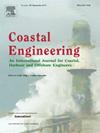不规则波浪下的床层剪切应力的实验室测量
IF 4.5
2区 工程技术
Q1 ENGINEERING, CIVIL
引用次数: 0
摘要
研究了破碎波涡在平面坡面上的溢出和倾入规则波所引起的床层剪应力。采用体积三分量测速(V3V)系统对内冲浪区自由表面至底部进行了三分量三维(3C3D)速度测量。利用粒子图像测速(PIV)系统获得了底部边界层内部的高分辨率二维(2D)速度测量结果,补充了3C3D测量结果。利用速度梯度法,根据粘性亚层的实测速度确定了床层剪应力。利用实测数据研究了大涡流的演化过程及其诱发的床层剪应力特征。结果表明,在溢出波和俯冲波中,大涡流的基本三维结构都是由两个反向旋转且动量较强的涡流组成的相干涡环。在倾降波中,破碎波涡撞击波峰下底部,在波致(平均)流向岸边时引起较大的床层剪应力波动,而在溢浪中,破碎波涡到达底部较晚,在水流反转后主要影响负床层剪应力。当边界层不受破碎波湍流扰动时,近床速度分布与层流/过渡型湍流中非破碎波的速度分布相似。黏性亚层和大部分缓冲层在波峰期和波谷期发育,但并不总是存在对数区。研究发现,在涡旋冲击过程中,瞬时速度一般不符合壁面分布规律,Spalding壁面函数在某些情况下低估了床层剪应力,而在另一些情况下则高估了床层剪应力。研究还发现,仅在床层上方一小段距离处测量的流体剪应力严重高估了瞬时床层剪应力,并且只有在床层区域发生扫掠型事件时,两者之间才存在良好的相关性。本文章由计算机程序翻译,如有差异,请以英文原文为准。
Laboratory measurements of bed shear stress under spilling and plunging regular waves
The bed shear stress induced by breaking-wave-generated vortices on a plane slope was investigated for spilling and plunging regular waves. Three-component, three-dimensional (3C3D) velocity measurements were conducted from the free surface to the bottom in the inner surf zone using a Volumetric Three-Component Velocimetry (V3V) system. The 3C3D measurements were supplemented by high resolution two-dimensional (2D) velocity measurements inside the bottom boundary layer obtained using a Particle Image Velocimetry (PIV) system. The bed shear stress was determined from the measured velocities in the viscous sublayer using the velocity gradient method. The measured data were used to study the evolution of the large eddies and the characteristics of their induced bed shear stresses. The results showed that, in both spilling and plunging waves, the basic three-dimensional (3D) structure of the large eddies was a coherent vortex loop consisting of two counter-rotating vortices with strong downward momentum. Breaking wave vortices impinged on the bottom under the wave crest in plunging waves and induced large bed shear stress fluctuations when the wave-induced (mean) flow was shoreward, while they reached the bottom later in spilling waves and mainly affected the negative bed shear stresses after flow reversal. When the boundary layer was not disturbed by breaking wave turbulence, the near-bed velocity profile was similar to that observed in non-breaking waves in the laminar/transitional turbulent flow regime. The viscous sublayer and most of the buffer layer were developed by the time of the wave crest and wave trough phases, but a logarithmic region did not always exist. It was found that the instantaneous velocities did not generally conform to a law-of-the-wall profile during vortex impingement and the Spalding wall function underpredicted the bed shear stress in some cases but overpredicted in others. It was also found that the fluid shear stress measured at only a small distance above the bed grossly overestimated the instantaneous bed shear stress, and that a good correlation between the two parameters was observed only when sweep type events occurred in the bed region.
求助全文
通过发布文献求助,成功后即可免费获取论文全文。
去求助
来源期刊

Coastal Engineering
工程技术-工程:大洋
CiteScore
9.20
自引率
13.60%
发文量
0
审稿时长
3.5 months
期刊介绍:
Coastal Engineering is an international medium for coastal engineers and scientists. Combining practical applications with modern technological and scientific approaches, such as mathematical and numerical modelling, laboratory and field observations and experiments, it publishes fundamental studies as well as case studies on the following aspects of coastal, harbour and offshore engineering: waves, currents and sediment transport; coastal, estuarine and offshore morphology; technical and functional design of coastal and harbour structures; morphological and environmental impact of coastal, harbour and offshore structures.
 求助内容:
求助内容: 应助结果提醒方式:
应助结果提醒方式:


